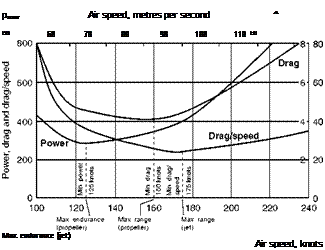Flying for endurance – jet propulsion
If the argument has been followed so far, there will be no difficulty in understanding the problem of maximum endurance for jet-driven aircraft. Since fuel consumption is roughly proportional to thrust, we shall get maximum endurance by flying with minimum thrust, i. e. with minimum drag. So the endurance speed of a jet aircraft corresponds closely to the range speed of a propeller-driven aircraft, and from the comfort point of view, this makes the jet aircraft easier to fly in the condition of maximum endurance.
Since the thrust, and hence the consumption, should be the same at the same indicated speed at any height, it should not matter at what height we fly for endurance.
Summary
Table 5.5 and Fig. 5.13 summarise the difference between jet and propeller – driven aircraft so far as range and endurance are concerned. They must be considered as a first approximation only – they take into account the aeroplane efficiency for the propeller-driven type (neglecting propeller and engine efficiency), and both aeroplane and propulsive efficiency for the jet-driven type (neglecting engine efficiency). All this means is that the more important factors have been taken into account, and the less important factors have been neglected. It is not the whole story, and should not be considered as such.
 |
The figures in brackets in Table 5.5 are the speeds in knots for the particular aircraft that has been considered in this chapter.
|
Table 5.5 Range and endurance differences
|
Fig 5.13 Power, drag and drag/speed curves
Before leaving this important subject it should be made clear that flying control regulations, made in the interests of safety, may sometimes make it necessary to fly at flight levels which do not exactly correspond to the best interests of either aircraft or engines.
Can you answer these?
1. What are the four most important forces which act upon an aeroplane during flight?
2. What are the conditions of equilibrium of these four forces?
3. Are these forces likely to alter in value, and to move their line of action during flight?
4. Explain how it is that an aeroplane can fly level at a wide range of air speeds.
5. Is the relationship between air speed and angle of attack the same at height as at sea-level?
6. What is the effect of weight on the relationship between air speed and angle of attack?
7. On a propeller-driven aircraft –
(a) Why will we get less range if we fly too high?
(b) At what height should we fly for best endurance?
(c) Why is the air speed for best endurance different from the air speed for best range?
8. On a jet-driven aircraft –
(a) Under what conditions should we fly for maximum range?
(b) At what height should we fly for maximum range?
(c) At what speed and height should we fly for maximum endurance?
For solutions see Appendix 5.
In Appendix 3 you will find some simple numerical examples on the problems of level flight.











